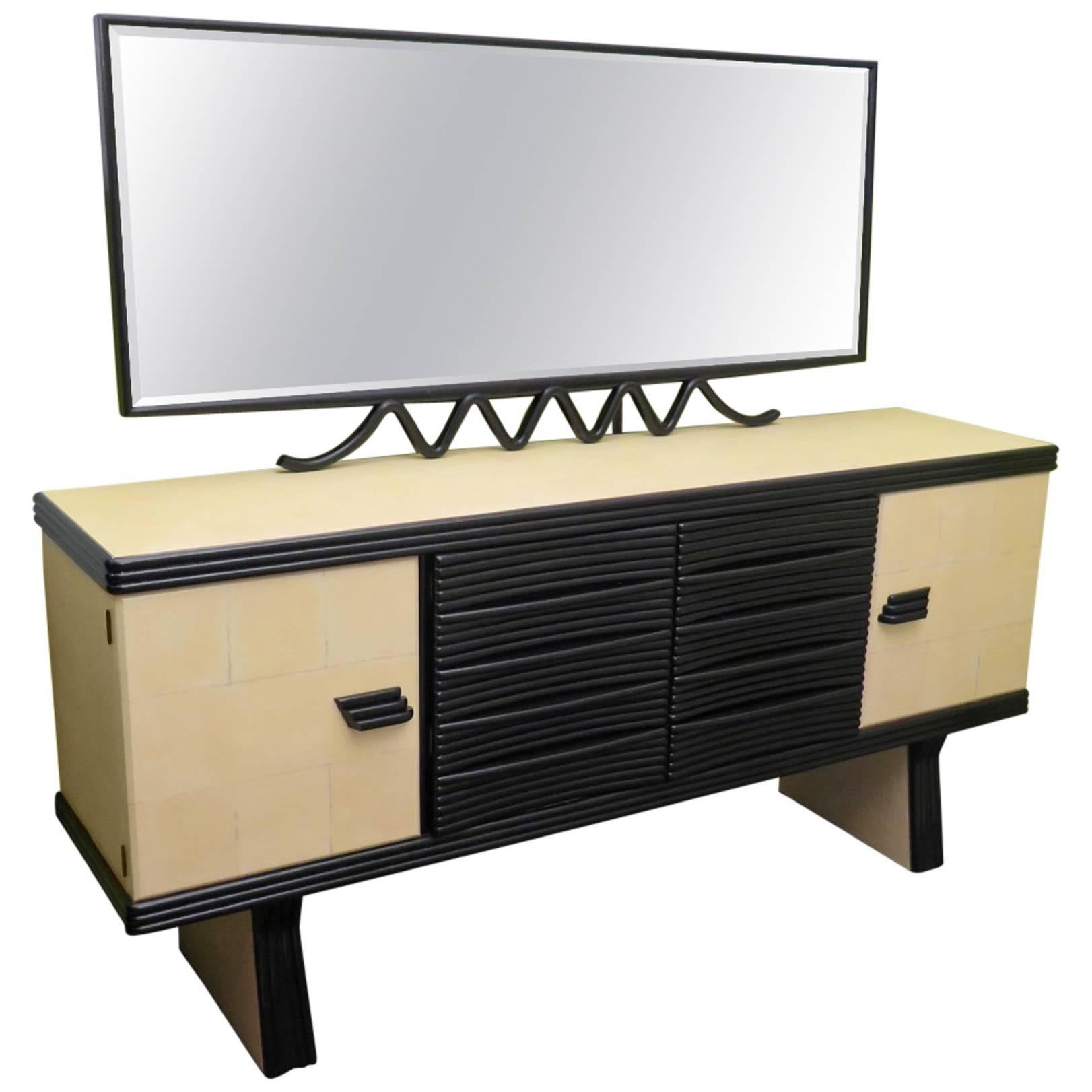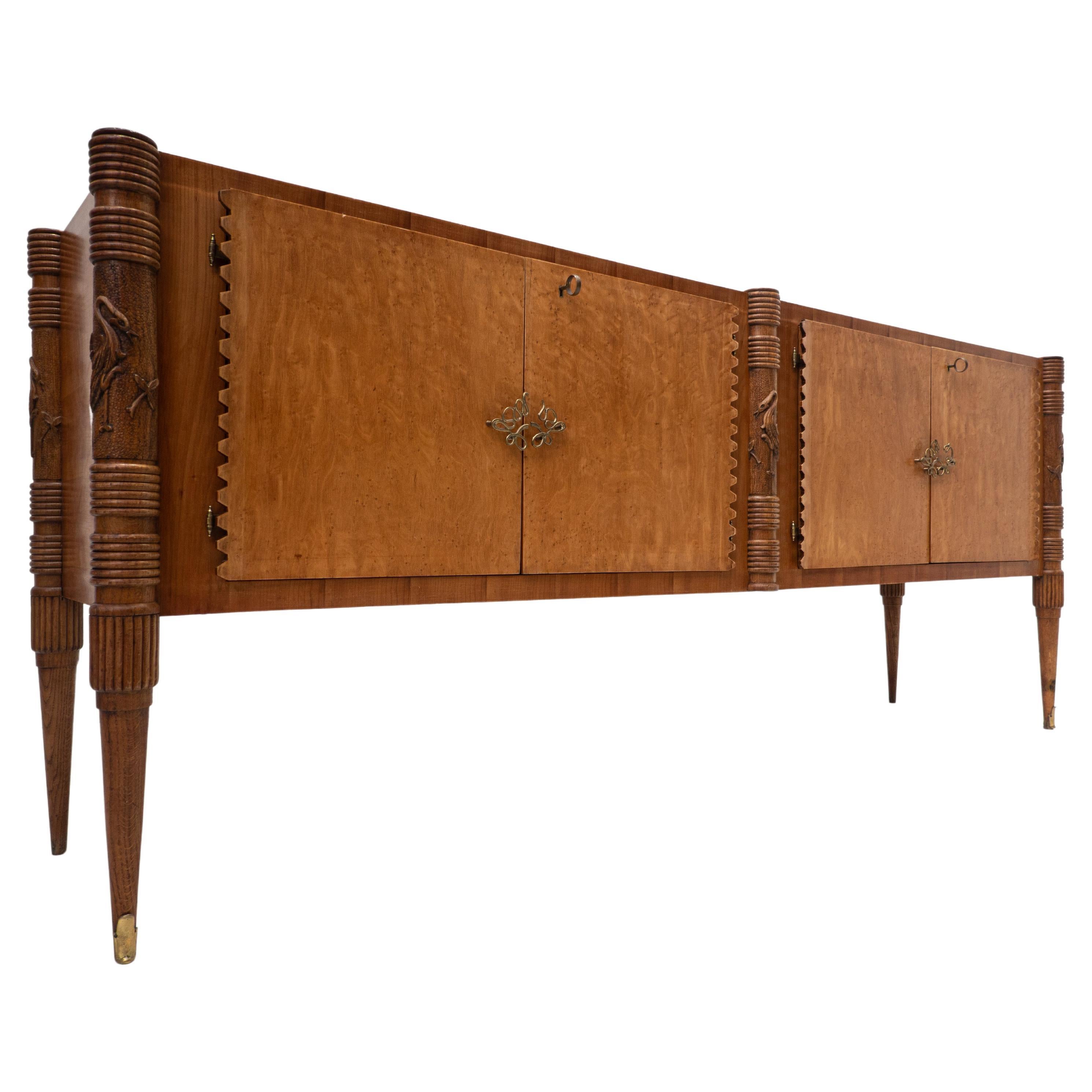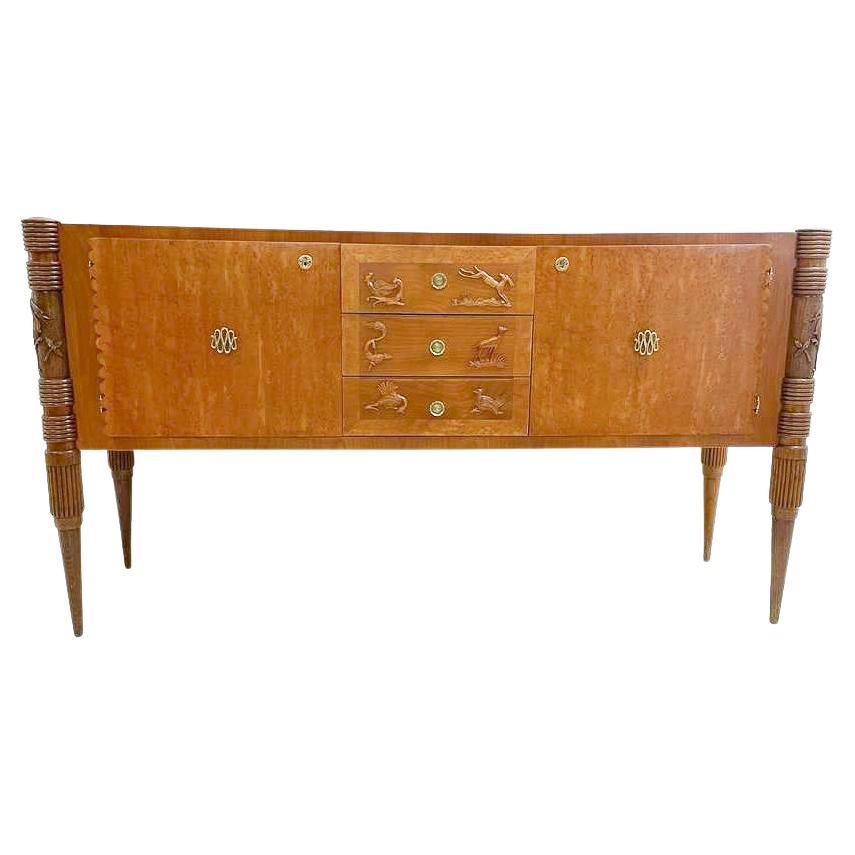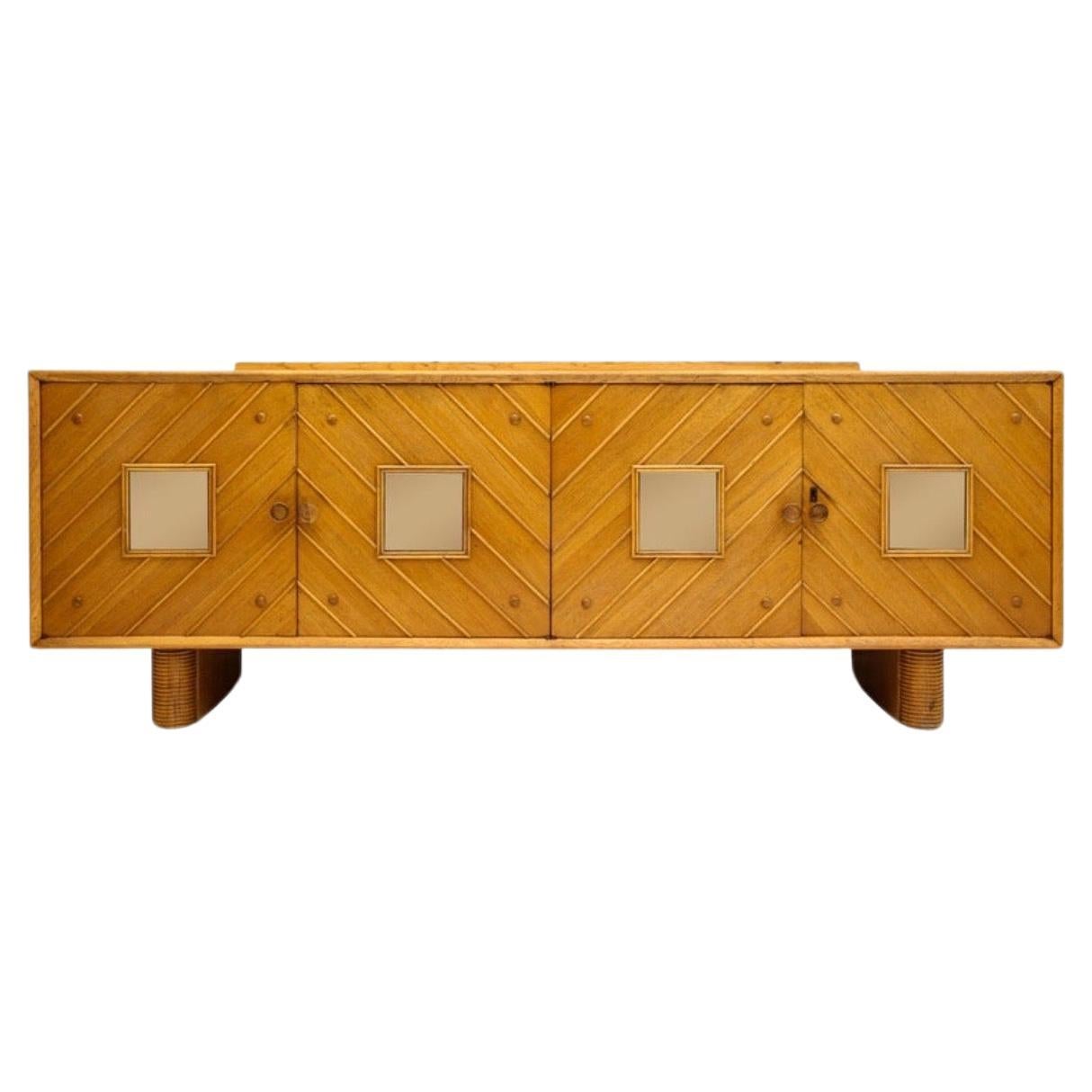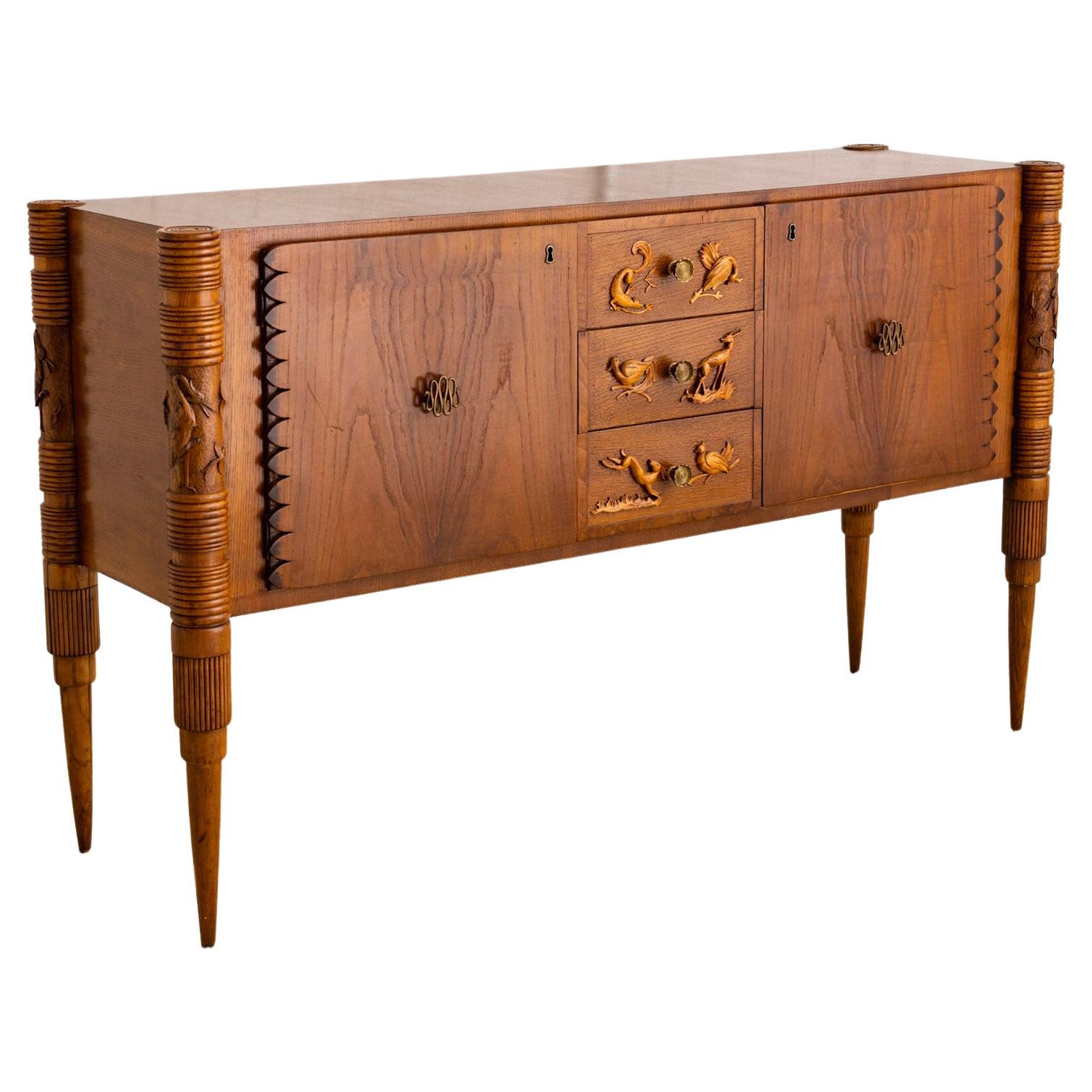Items Similar to Pier Luigi Colli Large Sideboard in Wood with Drawers Italian Manufacturer 1930s
Want more images or videos?
Request additional images or videos from the seller
1 of 7
Pier Luigi Colli Large Sideboard in Wood with Drawers Italian Manufacturer 1930s
About the Item
Large sideboard is entirely realized in oak wood, with four drawers on each side (for a total of eight drawers) and a central storage unit.
Designed by Pier Luigi Colli Italian Manufacture from 1938 ca.
To reconstruct the story of Pier Luigi Colli, we must take a leap back to the 19th century in Turin, a multifaceted city, in some ways controversial due to its austere and sometimes introverted character, but at the core of a creative drive: and if it is primarily known for its automobile industry, there was a time when Turin was at the height of fame also in the field of furniture and embroidery, thanks to the presence of two entrepreneurial realities.
On the one hand there was the MIRAM (Italian Hand-Made Embroidery Manufacture) founded by Pietro Colli in 1850, specializing in gobelin fabrics and bandera embroideries. His daughter Teresa traveled between Italy and Paris to discover the latest trends in fabrics and embroidery, while her younger brother, Pier Luigi Colli (1895-1968), the star of this story, joined the company in 1921. Distinguishing himself for his enterprising personality and willing to continue his father's profession, Pier Luigi was known to his contemporaries as "the artist interior designer", and had no doubts about his future: he moved temporarily to Paris, where he attended L'Ecole des Beaux Arts Décoratives.
The other great Turin manufacturer to be mentioned is Martinotti, founded in 1931 by Giuseppe Martinotti and supplier of fine furnishings for the Savoy court, pieces which were characterized by a typically 19th century eclectic style, generally made of exotic woods featuring ivory and tortoiseshell inlays: at that time, Martinotti represented the top of internationality, having even participated in the 1875 Philadelphia exhibition!
The two brands' fate merged in 1902, a decisive year for Turin which, hosting the International Exhibition of Modern Decorative Art, became the cradle of the spread of the Liberty style in Italy. In the exhibition, Martinotti exhibited an elegant interior, in which all the textile parts, from the curtains to the seat upholstery, was made by Colli. It was in 1926 that Colli (MIRAM) finally acquired Martinotti, founding a laboratory where, from the savoir faire of the two companies, complete pieces of furniture were created and tailor-made for the customer, from the structure to its upholstery.
Meanwhile, Pier Luigi Colli was living in Paris, the ideal place to be in 1925, when the International Exhibition of Modern Decorative and Industrial Arts brought him closer to the work of one of his putative fathers, the great French cabinet maker Jacques-Émile Ruhlmann (Paris, 1879 - 1933). Thanks to Paris, Pier Luigi intertwined contacts with the international beau monde, he started to import Lalique glass from France, while the Colli's clientele expanded and special commissions arrived, such as the creation of the Royal Train of the Savoy family made with Fiat, or the lecture hall in the University of Turin.
The success of a brand is also measured by its openness to establishing collaborations with the great designers of its time, in the case of Colli resulting in important creative partnerships: from Gio Ponti, who relied on the brand for his Richard Ginori project in Rome, up to Carlo Mollino, who created with Colli the handrails of the RAI (national TV) auditorium and the windows of the Teatro Regio in Turin; also in Turin, the Morbelli architects collaborated with Colli for the furnishings of the RAI skyscraper, and the architects Gabetti Isola for the interiors of the Stock Exchange in Turin.
In the 40s and 50s, having opened a branch in Rome, Colli was at the peak of productivity. The embroidery and textile section continued to be one of its strengths, keeping alive the relations with France and its great masters: among the inspirations were the geometric shapes of the fabrics of Ruhlmann's interiors, or the tactile carpets made by designer Mariod Dorn. And so, another Colli trademark become the "textured carpet", in which the decoration was not dictated by the design, but by the different height of the wool!
When Pier Luigi died in 1968, his daughter Claudia succeeded him; Colli2 was created, a collection of furniture designed by Guido Drocco and Franco Mello, authors of the iconic Catus for Gufram, while the artistic direction was entrusted to Giorgio De Ferrari. Collaborations continued with the most famous Turin designers, such as Giuseppe Raimondi, even if the production of the brand began to be a bit "behind" with respect to the mass production boom that had conquered the world in the meantime. The final decision was to maintain the brand ethic and identity, by limiting itto acting as a design studio, until the final closure, which took place in the mid-80s.
- Creator:Pier Luigi Colli (Designer)
- Dimensions:Height: 39.38 in (100 cm)Width: 79.14 in (201 cm)Depth: 17.52 in (44.5 cm)
- Style:Mid-Century Modern (Of the Period)
- Materials and Techniques:
- Place of Origin:
- Period:
- Date of Manufacture:1938 circa
- Condition:Wear consistent with age and use.
- Seller Location:Montecatini Terme, IT
- Reference Number:1stDibs: LU5304229846852
About the Seller
4.9
Gold Seller
These expertly vetted sellers are highly rated and consistently exceed customer expectations.
1stDibs seller since 2020
99 sales on 1stDibs
Typical response time: <1 hour
- ShippingRetrieving quote...Ships From: Borgo a Buggiano, Italy
- Return PolicyA return for this item may be initiated within 7 days of delivery.
More From This SellerView All
- Emilio Lancia Large Sideboard in Walnut Wood Italian Manufacture 1930sBy Emilio LanciaLocated in Montecatini Terme, ITA mid-century sideboard with structure in walnut veneer with brass details, the sideboard presents three doors and six inner shelves. Designed by Emilio Lancia, Italian manufacture ...Category
Vintage 1930s Italian Mid-Century Modern Sideboards
MaterialsBrass
- Giovanni Michelucci Torbecchia Sideboard in Walnut Wood by Poltronova 1964By Poltronova, Giovanni MichelucciLocated in Montecatini Terme, ITTorbecchia sideboard is entirely realized in solid veneered walnut wood, with two frontal hinging doors (inner shelves), two drawers, and a storage unit under the openable top part. ...Category
Vintage 1960s Italian Mid-Century Modern Sideboards
MaterialsWalnut, Wood
- Giotto Stoppino Sheraton Sideboard in Black Lacquered Wood by Acerbis 1977By Giotto Stoppino, AcerbisLocated in Montecatini Terme, ITSheraton sideboard presents two sliding doors that slide outward to expose three inner storage units with glass shelves and four drawers on the central part. The sideboard has a str...Category
Vintage 1970s Italian Mid-Century Modern Sideboards
MaterialsLaminate, Wood, Ash
- Gio Ponti Large Green Vase in Ceramic by Richard Ginori 1930s ItalyBy Gio Ponti, Richard GinoriLocated in Montecatini Terme, ITLarge vase in green ceramic designed by the Italian designer Gio Ponti and manufactured by Richard Ginori between the 1930s and the 1940s. In this piece, the ceramic was modeled with an elegant and raffinate, flared shape that makes it a perfect decorative vase. The manufacturer's brand is stamped under the base. The history of the Ginori Manufactory began in Doccia, just a stone's throw away from Florence, when in 1735 Marquis Carlo Andrea Ginori started a porcelain factory which was destined to become a worldwide icon of style. The eighteenth-century is a key century for the development of porcelain in Europe, in this period the first manufactures are born, fed by new styles and international trends. In stately homes, palaces and courtyards, the precious porcelain of the Doccia Manufactory is synonymous with elegance and refinement. The passage from the nineteenth, the century of reason to that of feeling marks a new chapter in the development of artistic taste and the manufacture of porcelain. Florence becomes the scene of a controversy between the academic supporters of the Beautiful ideal and the naturalists promulgators of the beautiful natural Since 1806 the direction of the Manifattura passed to Leopoldo Carlo Ginori Lisci who initiates a process of profound renewal. In 1986 The Manifattura expanded and the Richard Ginori Ceramic Company is born. The tradition of master craftsmen meets new technologies and the creations are perfected thanks to the use of new patents From 1923 to 1933 the artistic direction of the Manifattura was entrusted to Gio Ponti. The master is responsible for introducing highly innovative elements with sensitivity and respect for the taste for the ancient, and for the oriental culture. In 1925 at the Universal Exposition in Paris, the Manifattura and its artistic director were awarded the assignment to both of a Grand Prix. The Manufactory was renewed by relying on the experience of the greatest Italian designers of the time: Franco Albini, Franca Helg, Antonio Piva, Sergio Asti, Achille Castiglioni, Gabriele Devecchi, Candido Fior...Category
Vintage 1930s Italian Mid-Century Modern Vases
MaterialsCeramic
- Galleria Mobili d'Arte Cantù Sideboard in Wood with Doors and Drawers 1950sLocated in Montecatini Terme, ITWooden sideboard with three storage units (two larger and one small) and three frontal drawers with a structure entirely realized in wood and brass details (keys and feet). Manufac...Category
Vintage 1950s Italian Mid-Century Modern Cabinets
MaterialsBrass
- Luigi Genazzi Ovoidal Vase in Hammered Silver by Calderoni Jewels 20th ItalyBy Luigi Genazzi, CalderoniLocated in Montecatini Terme, ITOvoidal vase in hammered silver with a light ashlar surface. This elegant centerpiece was designed by Luigi Genazzi and produced by Calderoni Jewels. Marked under the base with the manufacturer's mark (Calderoni Jewellery) Datable in the second half of the 20th century. Calderoni was established in 1840 in Milan’s Via della Lupa, known today as Via Torino. At that time, Milan was a romantic city, dominated by the Habsburg dynasty. In 1870, Calderoni opened a prestigious establishment in Piazza Duomo, which soon became a point of reference for the city’s aristocracy. Calderoni became the official supplier of the House of Savoy...Category
Late 20th Century Italian Other Vases
MaterialsSilver
You May Also Like
- Italian Art Deco Sideboard by Pier Luigi Colli, 1930sBy Pier Luigi ColliLocated in Rome, ITElegant sideboard in ash and mahogany with magnificent legs that come out from the base. The same furniture is available the table, eight chairs, and the unique cabinet bar. Wanting ...Category
Vintage 1930s Italian Art Deco Sideboards
MaterialsAsh, Mahogany
- Pier Luigi Colli Midcentury Goatskin Black Shellac Credenza Sideboards, 1950By Pier Luigi ColliLocated in Rome, ITTaste and Italian flavor for this typical sideboard of Pier Luigi Colli. Classic in his design but very refined in the process of working of the materials. The sideboard consists of...Category
Vintage 1950s Italian Mid-Century Modern Sideboards
MaterialsGoatskin, Wood
- Large Italian Wooden Sideboard by Pier Luigi Colli with Four Doors, 1940sBy Pier Luigi ColliLocated in Brussels, BELarge Italian wooden sideboard by Pier Luigi Colli with four doors, 1940s.Category
Vintage 1940s Italian Mid-Century Modern Sideboards
MaterialsWood
- Mid-Century Italian Sideboard by Pier Luigi Colli, Ash Wood, 1940sBy Pier Luigi ColliLocated in Brussels, BEMid-Century Italian Sideboard by Pier Luigi Colli, Ash Wood, 1940sCategory
Vintage 1940s Sideboards
MaterialsWood
- Pier Luigi Colli Oak Buffet Mirror Sideboard, Midcentury, Italy, 1940s-1950sBy Pier Luigi ColliLocated in New York, NYPier luigi Colli oak sideboard, Mid-Century Modern, Italy, 1950s Beautiful oak sideboard. The oak has lovely patina throughout the piece. It is a large-scale sideboard with four do...Category
Vintage 1940s Italian Mid-Century Modern Cabinets
MaterialsOak
- Pier Luigi Colli Mid Century Sideboard with Relief CarvingsBy Pier Luigi ColliLocated in Brooklyn, NYA mid century Italian sideboard / credenza by designer Pier Luigi Colli. Carved animal reliefs and spindle legs with Art Deco influences. Brass accents. ...Category
Vintage 1940s Italian Art Deco Sideboards
MaterialsBrass
Recently Viewed
View AllMore Ways To Browse
Italian Furniture Manufacturer
1930 Furniture Manufacturers
1930s Italian Wood
Turin Vintage
Vintage Hall Cabinet
Italian Train
Casement Window Vintage
1930s Train
Vintage Storage Seat
Large Lalique
Midcentury Hall Cabinet
Large Industrial Cabinet
French Hall Cabinet
Vintage Embroidery Fabric
Drawers Artist
Embroidery Wood
Star Cabinet
Boom Vintage

